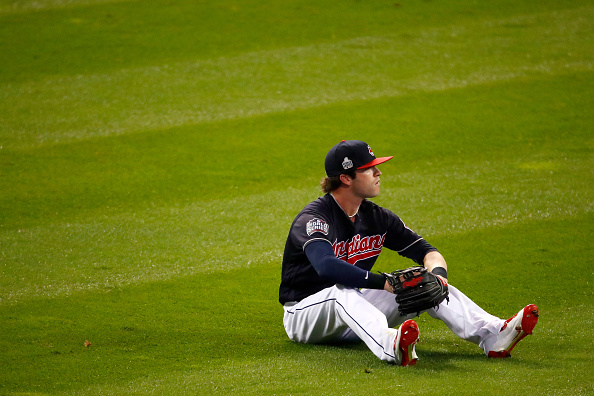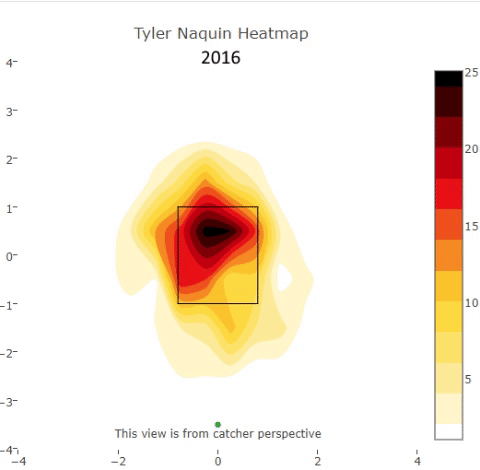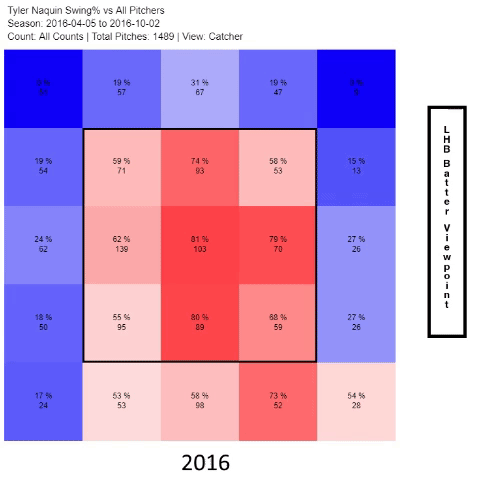In the baseball history books, a good version of Tyler Naquin will always exist. At age 25, the former first round pick was promoted to the MLB in 2016, and surprised many with his performance. Despite his status as a first round pick, Naquin wasn’t really a high-regarded prospect: he only was ranked #10 by Dan Farnsworth over at FanGraphs when he ranked Cleveland’s prospects before the 2016 season, and he never appeared in Baseball America’s MLB Top 100 rankings.
However, Naquin certainly looked like a top prospect during the 2016 season. After his second call-up to Cleveland of 2016 on May 13, Naquin was one of baseball’s best hitters through August, slashing .298/.370/.618 in 63 games. On top of his incredible production, Naquin produced the signature moment of Cleveland’s 2016 season, when he hit a walk-off inside-the-park home run against Toronto closer Roberto Osuna on August 19:
At the time of that home run, there was reason to believe at least some of Naquin’s success was sustainable. As it would turn out, it wasn’t.
Over the final 25 games of the season, Naquin’s slash line dipped to a mediocre .269/.402/.313. Then, in 11 2016 playoff games, Naquin was downright horrible, putting up a line of .174/.208/.261. All the while, he was playing awful defense in center field, posting a -17 Defensive Runs Saved during the regular season, and making this unforgettable blunder in the World Series:
http://www.youtube.com/watch?v=7JUXLzG2vYA
Though he ended up finishing third for AL Rookie of the Year, there wasn’t much buzz left around Naquin’s future, given his late-season slump. After a 2017 season where he only appeared in 19 games and put up a weak .216/.250/.270 line, Naquin was an afterthought, considering Bradley Zimmer‘s presence in center field and Greg Allen waiting in the minor leagues.
Just when it seemed Naquin’s career was dead and buried, a Lonnie Chisenhall calf injury opened the door for the now 27-year-old Naquin. To the surprise of many, Naquin has actually preformed well so far in 2018.
He’s currently slashing .319/.356/.391 in 73 plate appearances, good for a 102 wRC+. Further, he’s played primarily right field, where he has been above-average (5 Defensive Runs Saved, 2.1 Ultimate Zone Rating in 170.1 RF innings) – a stark contrast from his atrocious defensive ratings in center field during the 2016 season.
By all means, being an average offensive player while playing above-average defense is a useful combination, and many fans have taken notice of Naquin’s play:
Many of us may owe Tyler Naquin an apology.
Yes, he was shaky in the World Series. And his 2017 was forgettable.
But he's been really good in 2018. In right field and at the plate.
— Monte the Color Man (@Monte_Colorman) May 6, 2018
Tyler Naquin just needed consistent playing time to truly shine, I’ve always saud that
— Bryan (@NachoHelmet) May 5, 2018
Tyler Naquin is blossoming into a ballplayer. #Indians #RallyTogether
— Chris Burnham (@CMB1979) May 5, 2018
Despite the optimism around Naquin, we are still forced to ask whether or not his improved play is sustainable. Seeing as we’ve already experienced a Naquin “breakout” that was proven to be fool’s gold, we know the potential warning signs that a Naquin crash might be coming.
First and foremost, we must examine Naquin’s batting average on balls in play (BABIP). Generally, we know that BABIP usually stabilizes around .300, but can fluctuate due to foot speed, batted ball profiles, and exit velocity. Mike Trout‘s rare skillset allows him to carry a .355 career BABIP, while Edwin Encarnacion‘s slow speed and pull-heavy approach has limited him to a .271 career BABIP.
A significant part of Tyler Naquin’s success in 2016 came from carrying a completely unsustainable .411 BABIP. In 2016, Naquin only had one month with a BABIP below .400: August, where he hit .281 on balls in play. Though .281 is a somewhat normal BABIP, Naquin only could manage a 50 wRC+ when he wasn’t getting extremely lucky.
Perhaps you, the reader, know where this is going: BABIP is once again driving Naquin’s success in 2018. At the moment, it sits at .429, 18 points higher than his 2016 mark.
Considering Naquin’s sky-high BABIP, it’s actually concerning that he’s only produced at a roughly league-average rate in 2018, with a 102 wRC+. In large part, this is due to his power numbers:
The power Naquin displayed in 2016 has since disappeared, even if his BABIP luck hasn’t. Notably, he’s actually hitting the ball harder in 2018, but his lower launch angle means more of his hard-hit balls are staying on the ground, where they are less dangerous.
Another problem with Naquin in 2016 was his vulnerability in the upper-part of the strike zone, and his inability to lay off those pitches. We can see if this has changed significantly by using heatmaps. Below is gif of two heatmaps, showing Naquin’s swings and misses from 2016 vs. 2018.
Unfortunately, both heatmaps feature a dark red circle in the upper-part of the strike zone, meaning Naquin still has trouble making contact with those pitches. If you were optimistic, you might hope that Naquin has at least learned to swing at those pitches less frequently, but you would also be wrong. Here is another gif of heatmaps, comparing how often Naquin swung at pitches in 2016 vs. 2018.
It isn’t quite all bad news – Naquin has swung less significantly often at pitches up-and-in this season – but Naquin clearly is still having trouble laying off of pitches in the upper-third of the strike zone, where he struggles making contact.
Naquin’s overall strikeouts are down (30% strikeout rate in 2016 vs. 26% in 2018), but his walk rate has taken an even bigger hit (9.9% vs. 4.1%), which essentially negates any contact gains he’s made.
So what we have we learned about Naquin?
- He’s riding another unsustainable BABIP wave, which is inflating his overall offensive numbers.
- His defense in right field is significantly better than in center field.
- He is hitting the ball hard so far in 2018, but his high percentage of ground balls is sapping his power.
- His trouble with pitches at the top of zone from 2016 is largely still an issue.
- He is striking out less often in 2018, but he is also walking less often.
There are little silver linings to Naquin’s 2018 play, but his offensive profile still lacks plate discipline and a launch angle that increases fly balls. During his elite-stretch in 2016, those two factors were present, and when coupled with a high BABIP, it all resulted in All-Star like hitting.
However, both have vanished in the roughly 22 months since, and as a result, Naquin’s profile remains somewhat bleak. He remains best-suited for a role as a fourth outfielder. He isn’t valueless to Cleveland, but fans should also resist the temptation to say Naquin has “finally arrived.” Rather, the Naquin story-line currently going around is just a result of the ebbs-and-flows of the 182-game season.
Add The Sports Daily to your Google News Feed!



